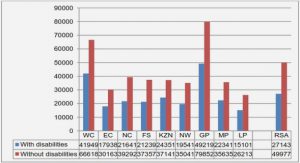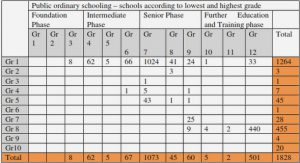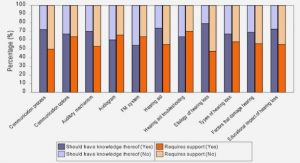Get Complete Project Material File(s) Now! »
Hydrogen supply subsystem
Hydrogen is usually supplied from a tank, where hydrogen is compressedly stored. Thanks to the valves, as well as the pressure regulator and the ow regulator, the hydrogen pressure and ow rate can be controlled. Hydrogen can be supplied either in dead-end or in a ow-through mode. In the dead-end mode, the hydrogen outlet is closed and the hydrogen is consumed in the fuel cells. Since the impurities, water vapor, and nitrogen diused from the cathode side may accumulate as operating, periodic purging of the hydrogen compartment is usually required [10]. In the owthrough mode, excess hydrogen is owed though the stack, which means that the anode stoichiometry ow rate (Sa) is more than 1. The unused hydrogen is returned to the inlet side either by an ejector or pump device. Separating and collecting any liquid water that may be present at the anode outlet is usually required for owthrough mode operation.
Humidication/water management subsystem
A strong relationship between proton conductivity and water content of the membrane exists in PEMFC, thus the membranes need to be maintained properly humidied to guarantee a satisfactory ion conductivity during stack operation. The water produced at cathode side and the air moisture is usually not sucient to maintain properly the membrane humidication [9]. One common way to solve this problem is to add humidiers which can humidify the air, the hydrogen, or both, before they enter the stack. Various humidication schemes could be employed such as bubbling of gas through water, direct water or steam injection, exchange of water through a water permeable medium, etc [10].
Heat management subsystem
In converting the chemical energy into electricity, the eciencies of PEMFCs are normally less than 60 % [4]. This means that more than 40 % of the chemical energy would be disposed as heat. It is found that running PEMFCs between 60 and 80 can obtain higher eciency [10]. To make the PEMFC stack operate in this favorable temperature interval, components for cooling must be employed. Several cooling methods have been studied, such as using highly thermal conductive material as heat spreaders, air ow cooling, liquid cooling, etc [5]. Notice that water and heat are considered as the byproducts of fuel cell operation. In some practical systems, they can be partially re-used, for instance, for humidication of the reactant gases.
Power conditioning subsystem
The electrical output voltage of a PEMFC stack is not constant when the stack is employed in a load-varying situation. Moreover, the output power of the stack is not often at the suitable voltage for the load. A DC/DC converter is used to regulate the stack voltage to a xed value, which can be higher or lower than the output stack voltage [5]. Notice that, depending on the application objects, more than one DC/DC converters may be needed to generate dierent output voltages. For instance, in the fuel cell vehicles, there are DC/DC converters used for auxiliary subsystems and the ones used for main power chain. The output power of the converter, which is designed for auxiliary subsystems, can be supplied to the components in auxiliary subsystems, such as compressors, cooling fans and start-up batteries. Following the DC/DC converter in the main power chain, the power inverter and electric motor are usually the main components. Fig. 1-5 shows the powertrain layout of Honda’s concept fuel cell vehicle [11].
Degradations of PEMFC system
It should be noticed that the cost related to PEMFC systems could be signicantly
decreased by large-scale manufacturing. Nevertheless, the durability problems have to
be worked out from the technological perspective. Even more, decreasing the quality
of the materials (catalysts) may be needed to further reduce the costs, the durability
could therefore be lowered in such cases. To improve the PEMFC system durability
performance, a good knowledge of the its degradation mechanism is necessary.
The stack is the heart of a PEMFC system, and the auxiliary subsystems serve
for the stack to make it operate eciently and safely. The performance of the stack
usually re ect the condition of the whole system. Performance degradations of the
stack can be impacted by various factors. Based on the in uencing factors, we can
classify the degradations into two categories: the degradations related to ageing eect
and the ones related to system operations.
1.4.1 Degradations related to ageing eect
The degradations related to ageing eect usually do not lead to catastrophic failure
that makes the system quickly lose the eciency, but simply to a gradual decrease in
performance. The degradations are not recoverable or reversible, such as the membrane
degradation due to loss of electrochemical surface area, the corrosion of the
catalyst layer [15]. This kind of degradations can be aected by many internal and
external factors, such as fuel cell design and assembly, the quality of materials, operational
conditions, etc. The improvement of material durability characteristic canessentially mitigate these degradations. A lot of researchers in chemical and mechanical
domains are working on mitigation the ageing eect related degradations.
Table of contents :
General introduction
1 Generalities on PEMFC systems and diagnosis
1.1 Principle of PEMFC functioning
1.2 PEMFC system
1.2.1 Air supply subsystem
1.2.2 Hydrogen supply subsystem
1.2.3 Humidication/water management subsystem
1.2.4 Heat management subsystem
1.2.5 Power conditioning subsystem
1.2.6 Control/supervision subsystem
1.3 Status and challenges of PEMFC development
1.3.1 Status of PEMFC development
1.3.2 Challenges of PEMFC development
1.4 Degradations of PEMFC system
1.4.1 Degradations related to ageing eect
1.4.2 Degradations related to system operations
1.4.2.1 Faults inside fuel cells
1.4.2.2 Faults on reactants supply
1.4.2.3 Faults on heat management
1.4.2.4 Faults on water management
1.4.2.5 Faults on electric circuit
1.4.2.6 Remarks
1.5 Fault diagnosis for PEMFC systems
1.5.1 Model-based diagnostic methods
1.5.1.1 Analytical model based
1.5.1.2 Black box model based
1.5.2 Data-driven diagnostic methods
1.5.2.1 Variables can be used
1.5.2.2 Multivariate analysis
1.5.2.3 Classication based
1.5.3 Challenges of online PEMFC system fault diagnosis
1.6 Conclusion
2 Experimental PEMFC stacks and experimentation framework
2.1 Test benches and stacks
2.1.1 Two test benches
2.1.2 Three PEMFC stacks
2.2 Experiments and database
2.2.1 Experiments and database of 20-cell stack
2.2.1.1 Normal operating (Nl)
2.2.1.2 Flooding (Ff ) and membrane drying (Fd)
2.2.2 Experiments and databases of 8-cell stack and 40-cell stack
2.2.2.1 High current pulse (F1)
2.2.2.2 Stop cooling water (F2)
2.2.2.3 High air stoichiometry (F3) and low air stoichiometry (F4)
2.2.2.4 CO poisoning (F5)
2.3 Role of individual cell voltages for diagnosis
2.4 Conclusion
3 Pattern classication tools for diagnosis: a comparative study
3.1 Approach principle
3.2 Data labeling methodologies
3.2.1 Pressure drop model
3.2.2 A statistical method for identication Ff and Fd
3.2.3 Data labeling result
3.3 Feature extraction
3.3.1 PCA
3.3.2 FDA
3.3.3 KPCA
3.3.4 KFDA
3.3.5 Remarks on feature extraction methods
3.4 Classication
3.4.1 GMM
3.4.1.1 Bayesian decision theory
3.4.1.2 GMM for modeling class-conditional probability function
3.4.2 kNN
3.4.3 SVM
3.5 Comparative results of dierent methodologies
3.5.1 Results on feature extraction and classication
3.5.2 Discussion about computation costs
3.6 Conclusion
4 Pattern classication for diagnosis: multi-fault FDI
4.1 DAGSVM for multi-fault FDI
4.2 Implementations of the diagnostic approach
4.2.1 Data labeling
4.2.2 FDA procedure
4.2.3 DAGSVM procedure
4.3 Results and discussion
4.4 Online implementation in an embedded system
4.4.1 Embedded system designed for PEMFC system diagnosis
4.4.2 Implementation results
4.4.2.1 Online fault diagnosis developing process
4.4.2.2 Algorithm integration test results
4.5 Conclusion
5 Pattern classication for diagnosis: novel fault recognition and online adaptation
5.1 Framework of the strategy
5.2 FDI and novel fault recognition
5.2.1 Problem mathematical description
5.2.2 SSM-SVM
5.2.3 Diagnostic rules
5.3 Online adaptation method
5.3.1 Incremental learning method for SSM-SVM
5.3.1.1 Incremental procedure
5.3.1.2 Upper limit on is
5.3.1.3 Recursive update of the inverse matrix
5.3.1.4 Incremental learning algorithm
5.3.1.5 Initialization procedure
5.3.2 Improvement of real-time learning performance
5.4 Results and discussion
5.4.1 Experiments and database
5.4.2 Multi-fault detection and isolation
5.4.3 Online adaptation
5.4.4 Detection a novel failure mode
5.4.5 Real-time capability
5.5 Conclusion
6 Partially model-based methodology for data-driven diagnosis
6.1 Background knowledge
6.1.1 Model description
6.1.2 Parity space model based fault diagnosis
6.1.3 Subspace model identication method
6.1.3.1 Identication of the intermediate matrices
6.1.3.2 Identication of system matrices
6.2 Description of the diagnostic strategy
6.2.1 Fault detection
6.2.2 Fault isolation in residual space
6.2.3 Overall framework of the strategy
6.3 Application of PEMFC diagnosis
6.3.1 Experiments and data acquisition
6.4 Results and discussion
6.4.1 Parity space identication
6.4.2 Fault detection
6.4.3 Fault isolation
6.5 Conclusion
Conclusion and Perspectives
Bibliography




